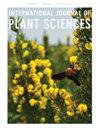Pollen Supplementation Alters How Flowering Phenology Affects Reproduction in a Spring-Flowering Herb
IF 1.6
3区 生物学
Q3 PLANT SCIENCES
引用次数: 0
Abstract
The timing of flowering and other components of phenology such as duration and synchrony can affect reproductive success and recruitment by influencing the environment a plant will experience throughout its flowering period. Pollination is a common explanation for why flowering phenology may affect reproduction, but it is not well understood how variation in pollination might interact with the abiotic environment to affect plant reproduction. Here we monitored a population of spring ephemerals, Claytonia virginica, for one flowering season and examined the effects of flowering phenology and the environment on plant reproduction in two treatments: plants supplemented with additional outcross pollen and unmanipulated control plants. Different aspects of reproduction were measured at both the population and within-plant levels: number of seeds produced by individual plants (seed production), per-fruit seed viability (the proportion of viable seeds out of the total number of seeds per fruit), percent germination, and number of days to germination. Soil surface temperature, light, and moisture data were also collected. The flowering phenology and environmental predictors most important for each measurement of reproduction differed between control and pollen-supplemented plants. For example, in both pollen treatment groups, more days in flower was consistently a positive predictor of seed production, but the environmental factors affecting seed production varied, with increasing pollinator visitation mostly affecting seed production in the nonsupplemented group and soil moisture positively affecting it in supplemented plants. Phenological and environmental predictors also differed for proportion of viable seeds and timing of germination. Our germination results support the hypothesis that the mechanisms that control early flowering time in the maternal plant may affect the timing of other life history events such as seed germination. Additionally, we show some evidence that changes in the maternal abiotic environment, particularly temperature, may alter progeny phenotype. No clear seasonal resource trade-offs were evident, as has been shown in other studies of spring ephemerals. Our results show that the abiotic environment interacts with the pollination environment to affect plant reproduction, with different environmental factors predicting reproduction in control versus pollen-supplemented plants.花粉补充改变开花物候对春花草本植物繁殖的影响
开花时间和物候学的其他组成部分,如持续时间和同步性,可以通过影响植物在整个开花期间所经历的环境来影响生殖成功和招募。传粉是开花物候影响生殖的一个常见解释,但传粉的变化如何与非生物环境相互作用影响植物生殖还不是很清楚。本研究对一个春夏短生植物(Claytonia virginica)种群进行了一个开花季节的监测,并研究了两种处理下开花物候和环境对植物繁殖的影响:外加异交花粉和未处理对照植物。在种群和株内水平上测量了繁殖的不同方面:单株产生的种子数量(种子产量),每果种子活力(每果种子总数中可存活种子的比例),发芽率和发芽天数。还收集了土壤表面温度、光照和水分数据。对照植物和补粉植物的开花物候和环境预测因子在各生殖测量指标上存在差异。例如,在两个花粉处理组中,花的天数都是种子产量的正向预测因子,但影响种子产量的环境因素各不相同,在未添加花粉处理组中,传粉者访问量的增加主要影响种子产量,而在添加花粉处理组中,土壤湿度的增加主要影响种子产量。物候和环境预测因子在活籽比例和发芽时间上也存在差异。我们的发芽结果支持了一个假设,即控制母体植物早期开花时间的机制可能会影响其他生活史事件的时间,如种子发芽。此外,我们还显示了一些证据,表明母体非生物环境的变化,特别是温度,可能会改变后代的表型。没有明显的季节性资源权衡,正如其他春季短暂性研究所显示的那样。我们的研究结果表明,非生物环境与授粉环境相互作用影响植物的繁殖,不同的环境因子预测对照和补粉植物的繁殖。
本文章由计算机程序翻译,如有差异,请以英文原文为准。
求助全文
约1分钟内获得全文
求助全文
来源期刊
CiteScore
4.50
自引率
4.30%
发文量
65
审稿时长
6-12 weeks
期刊介绍:
The International Journal of Plant Sciences has a distinguished history of publishing research in the plant sciences since 1875. IJPS presents high quality, original, peer-reviewed research from laboratories around the world in all areas of the plant sciences. Topics covered range from genetics and genomics, developmental and cell biology, biochemistry and physiology, to morphology and anatomy, systematics, evolution, paleobotany, plant-microbe interactions, and ecology. IJPS does NOT publish papers on agriculture or crop improvement. In addition to full-length research papers, IJPS publishes review articles, including the open access Coulter Reviews, rapid communications, and perspectives. IJPS welcomes contributions that present evaluations and new perspectives on areas of current interest in plant biology. IJPS publishes nine issues per year and regularly features special issues on topics of particular interest, including new and exciting research originally presented at major botanical conferences.

 求助内容:
求助内容: 应助结果提醒方式:
应助结果提醒方式:


